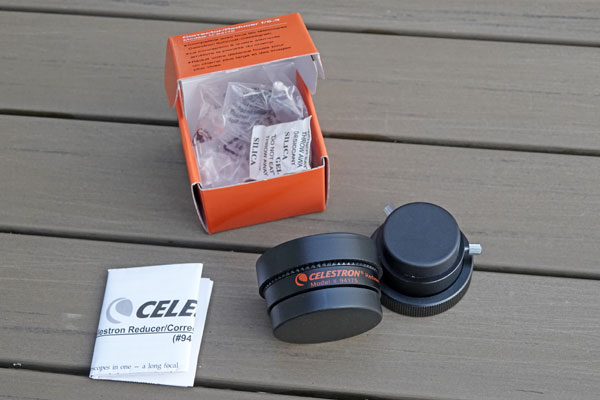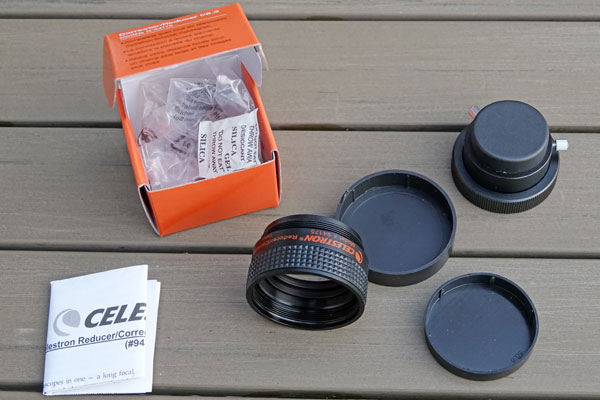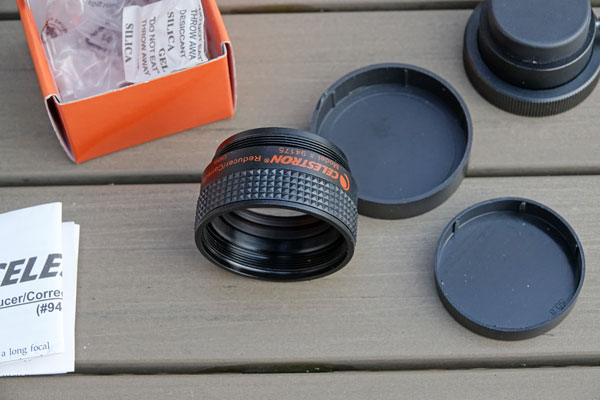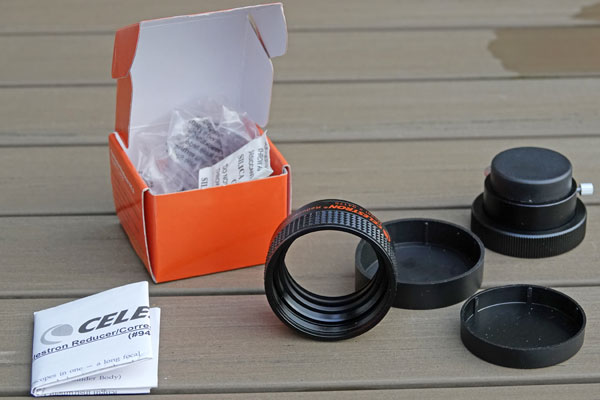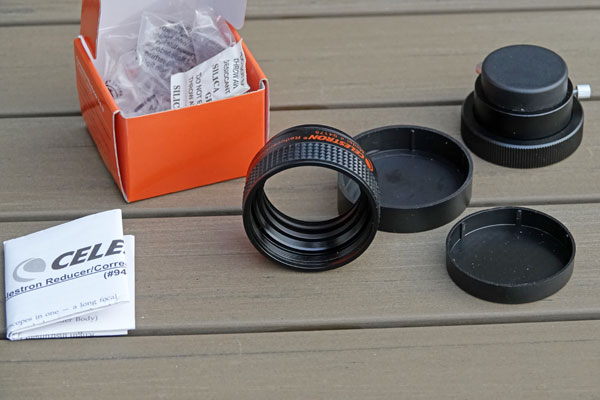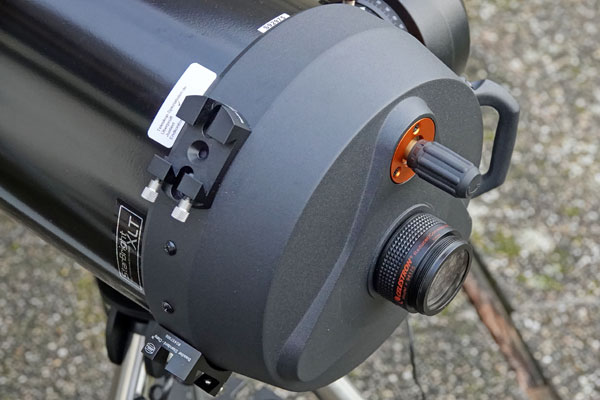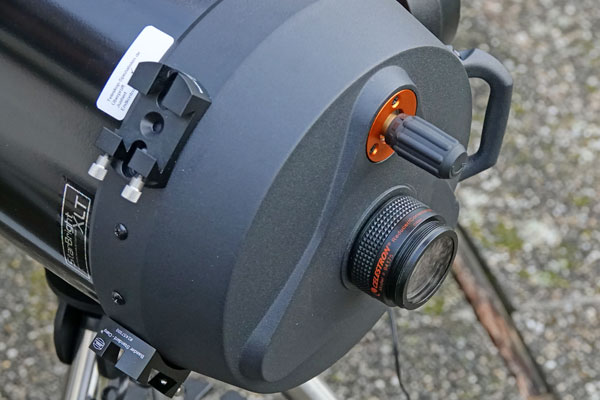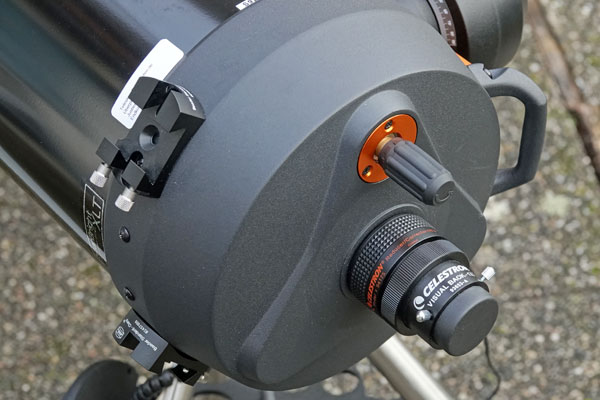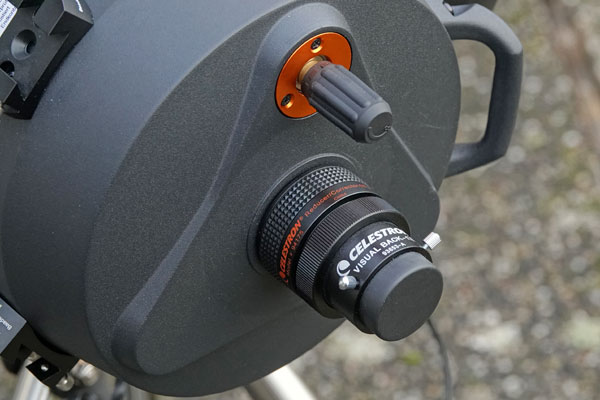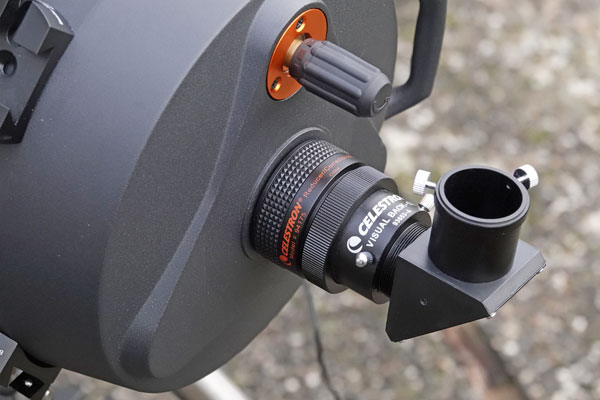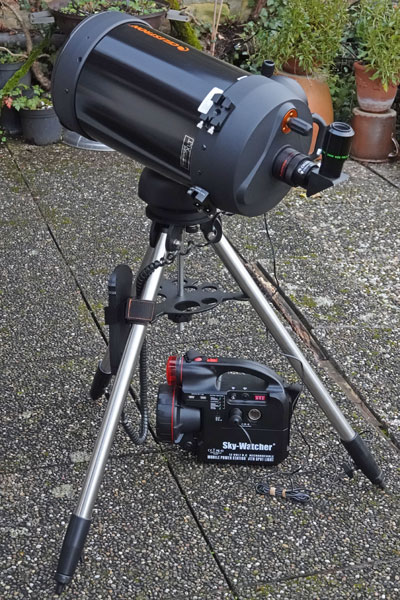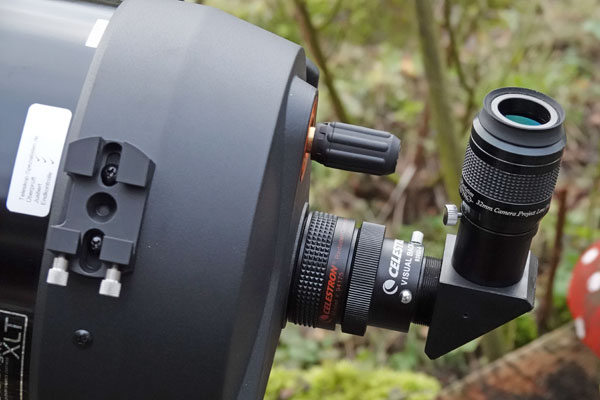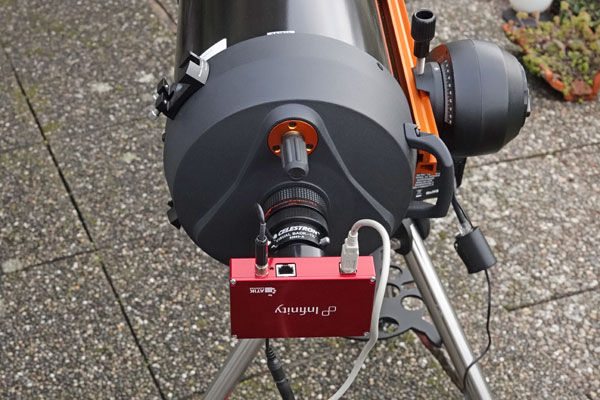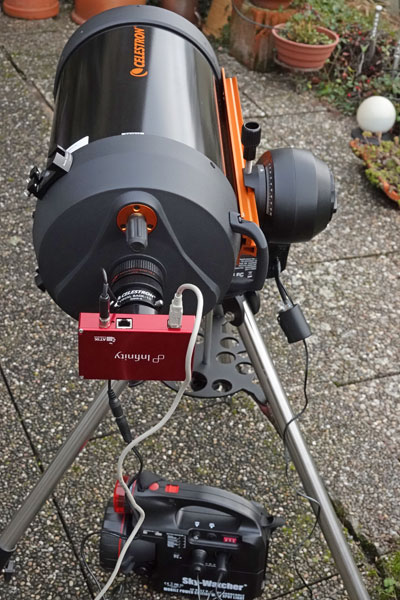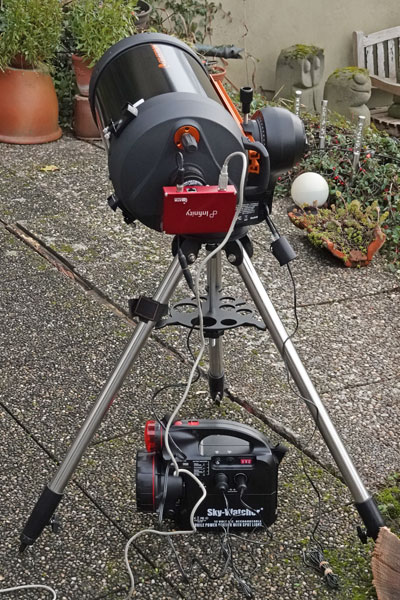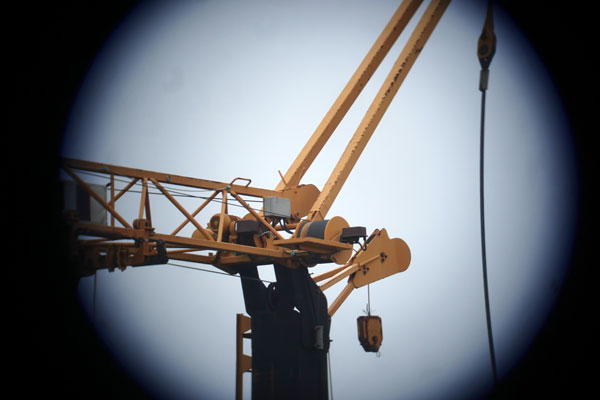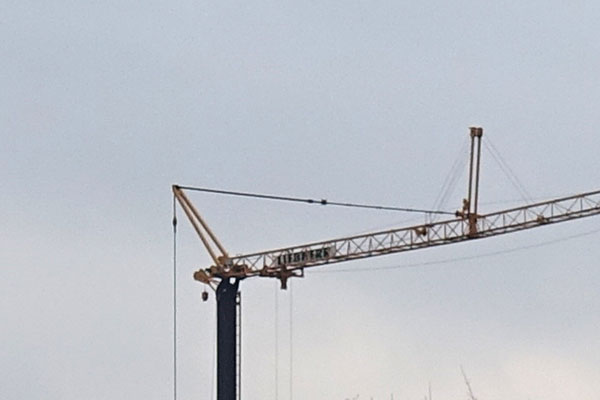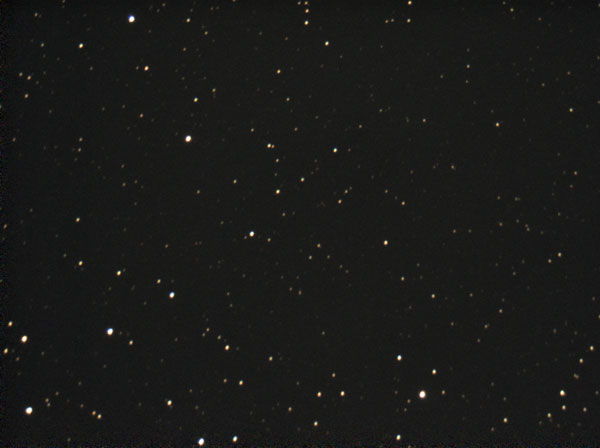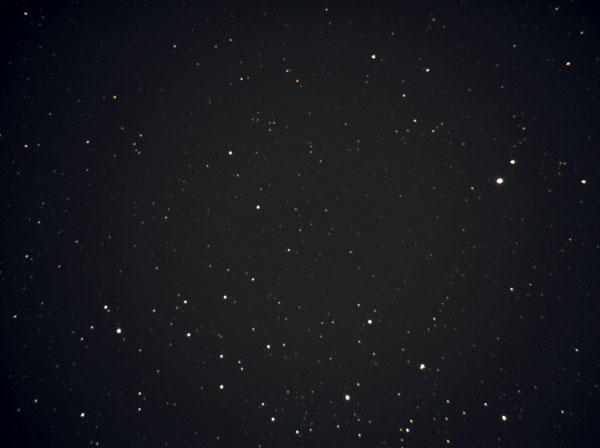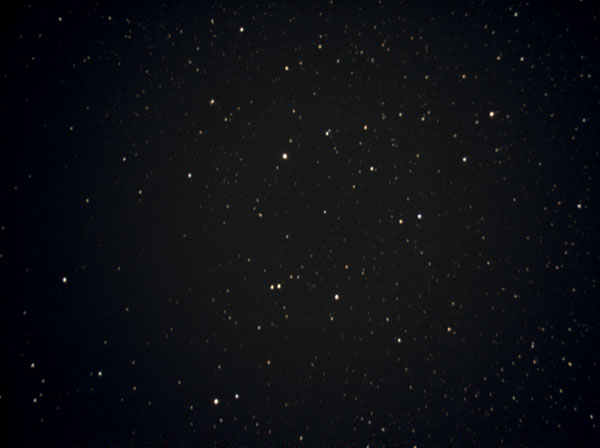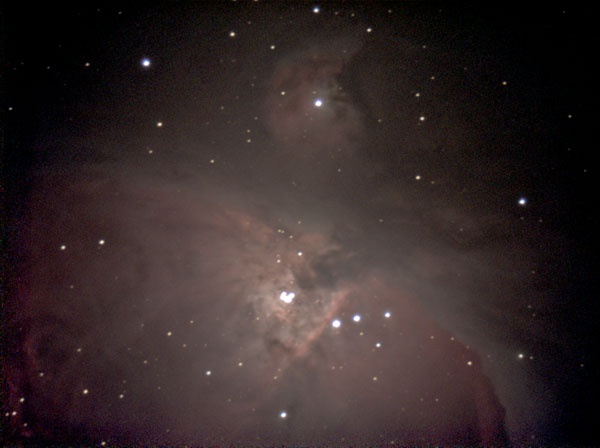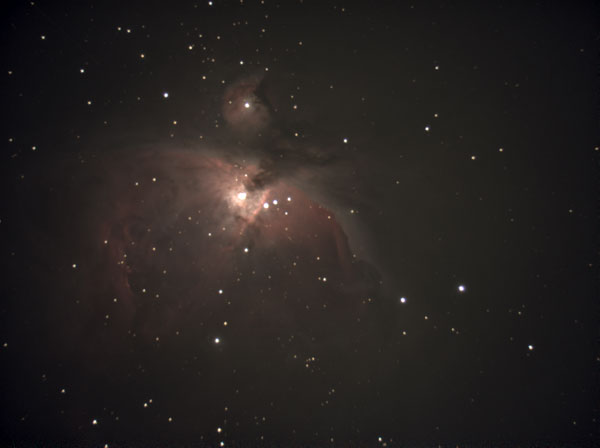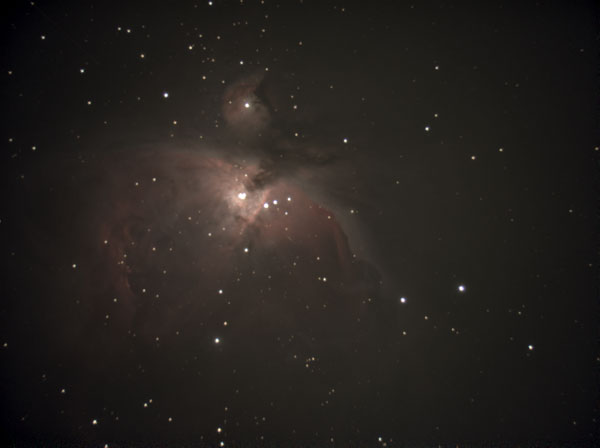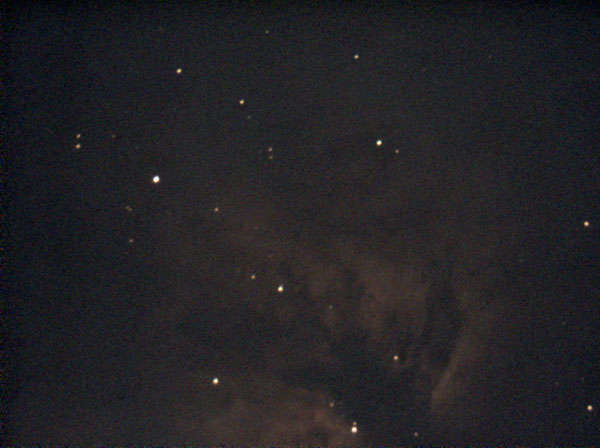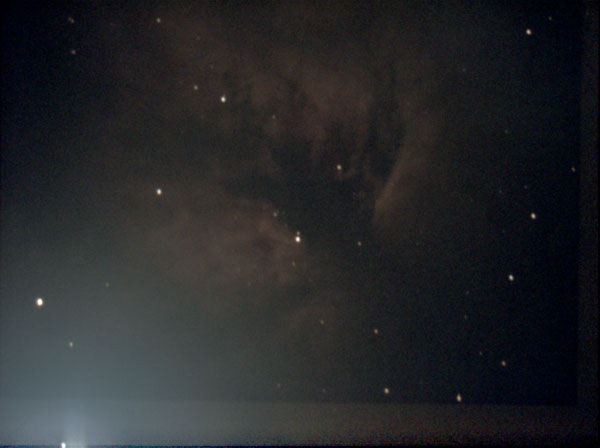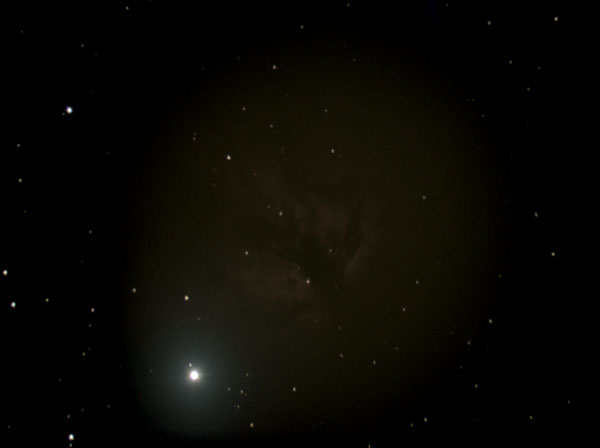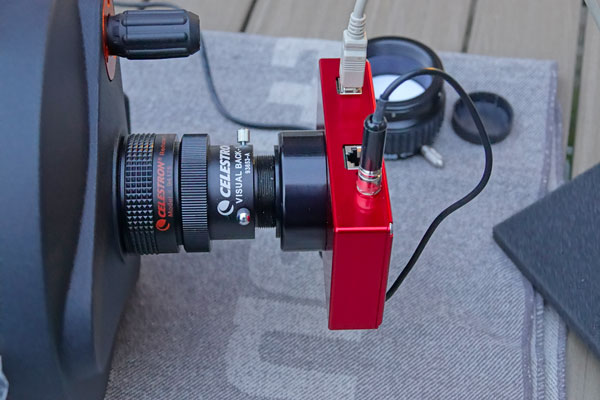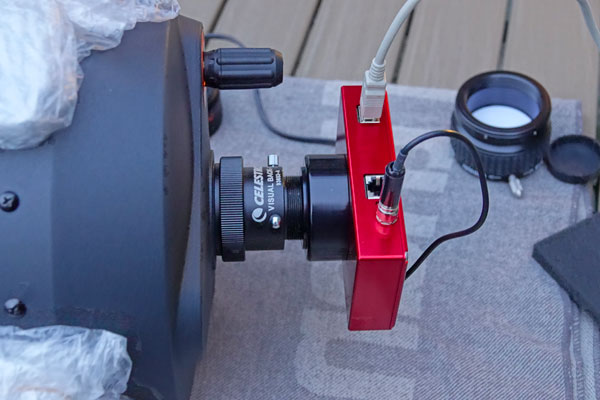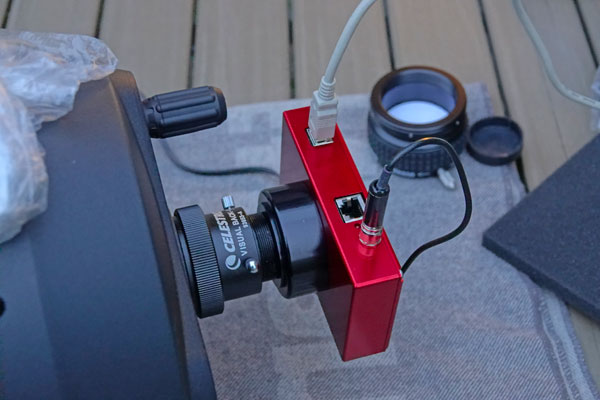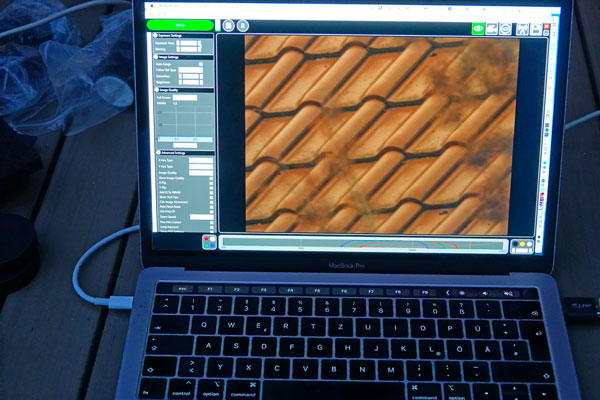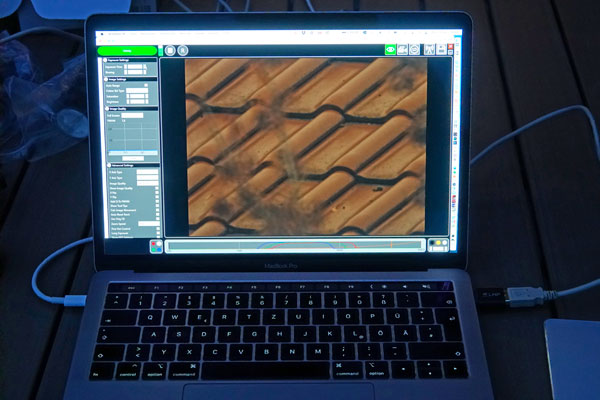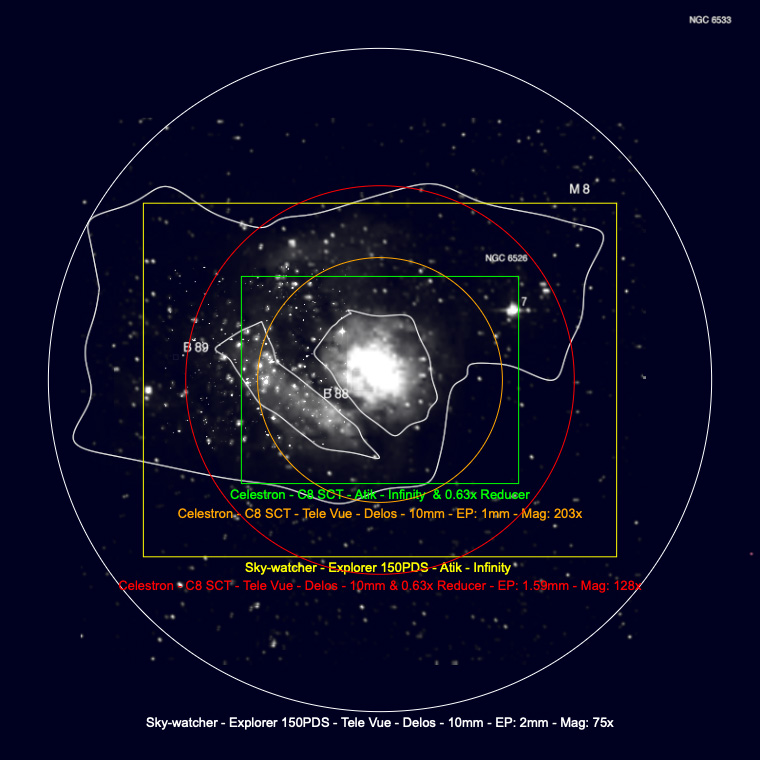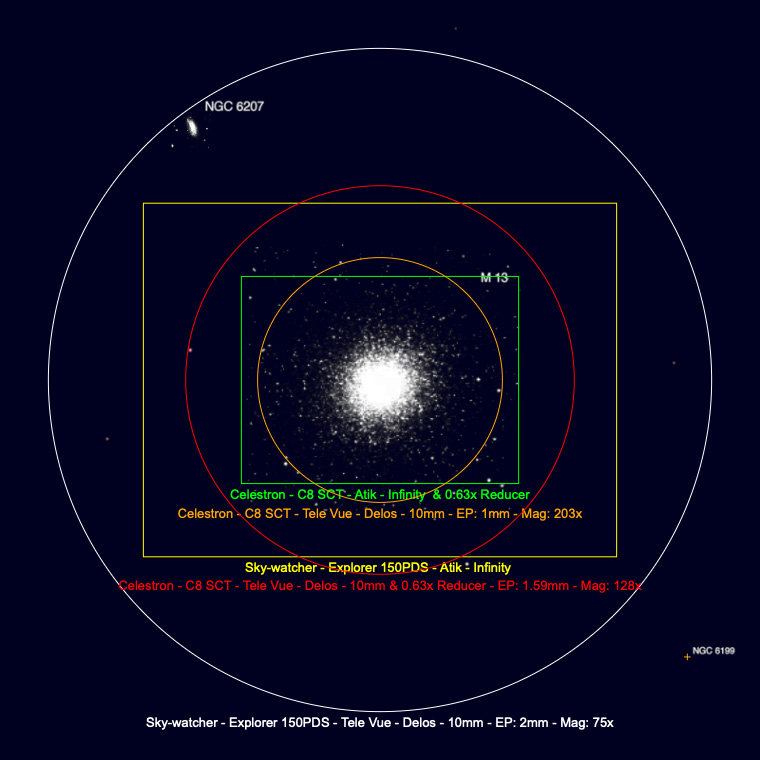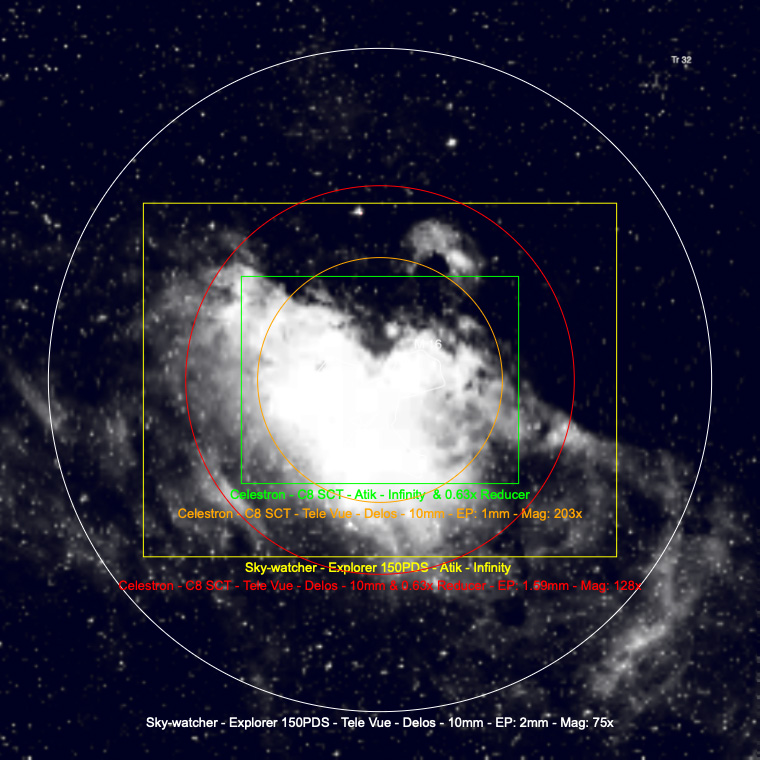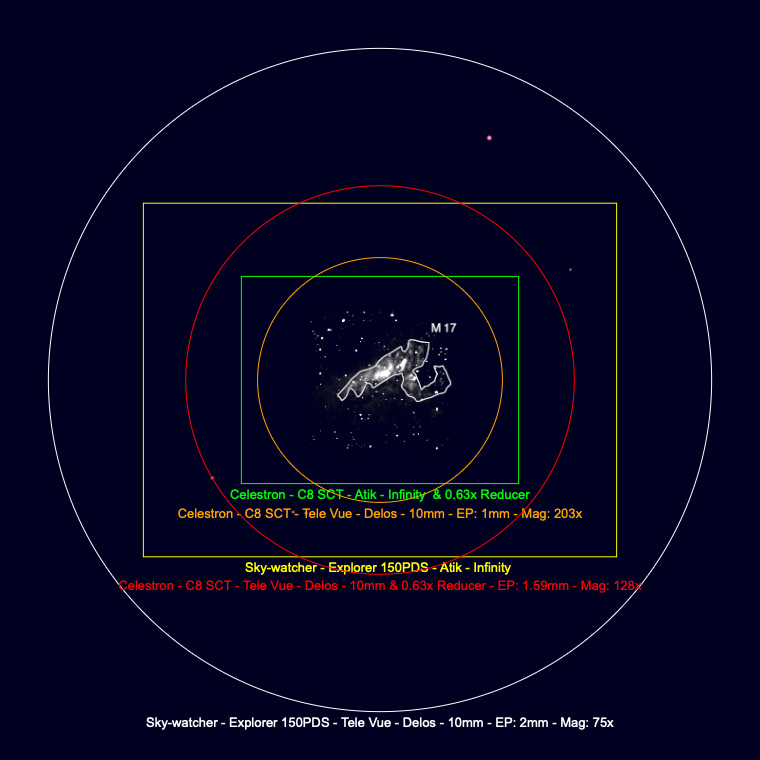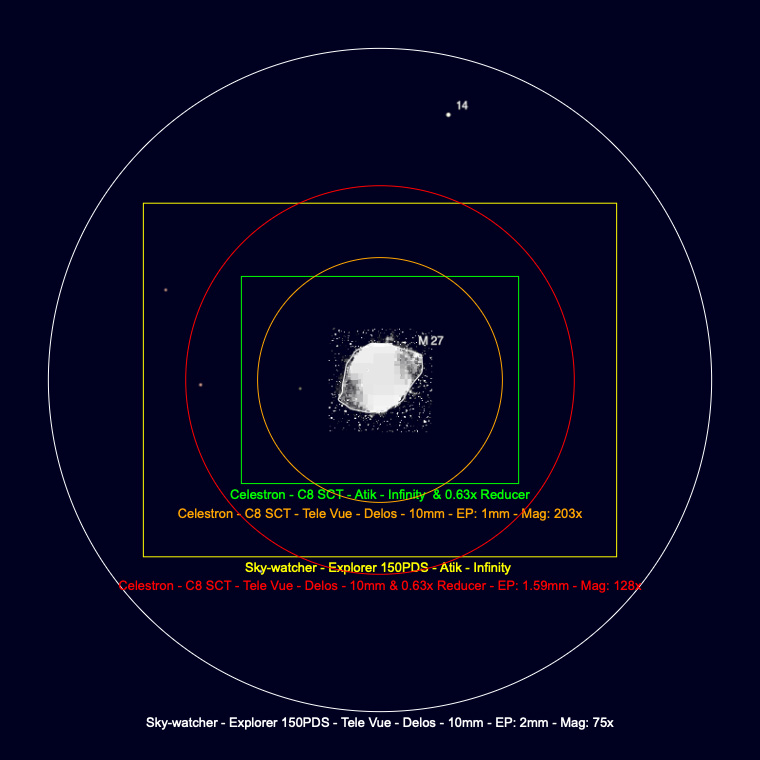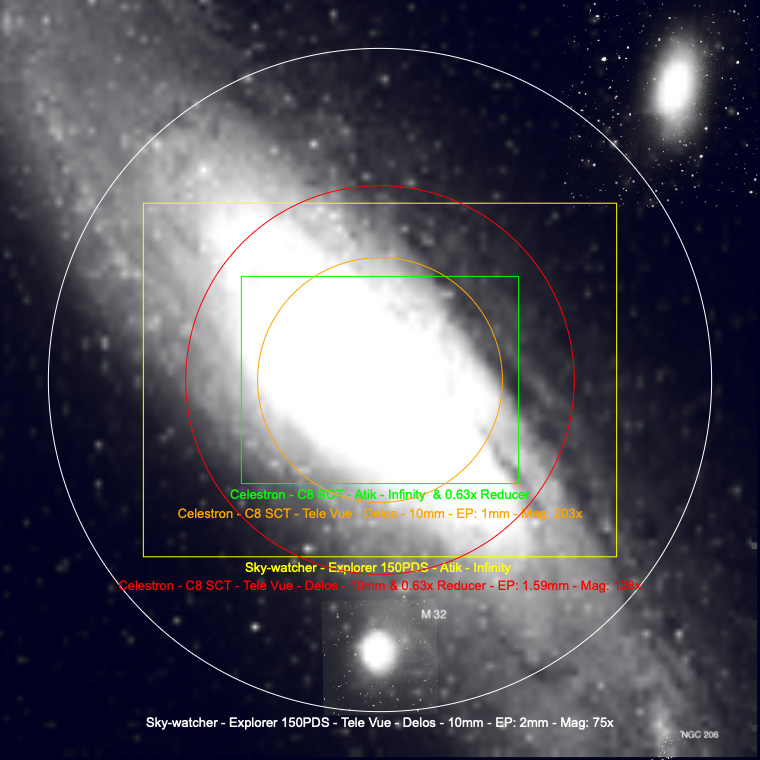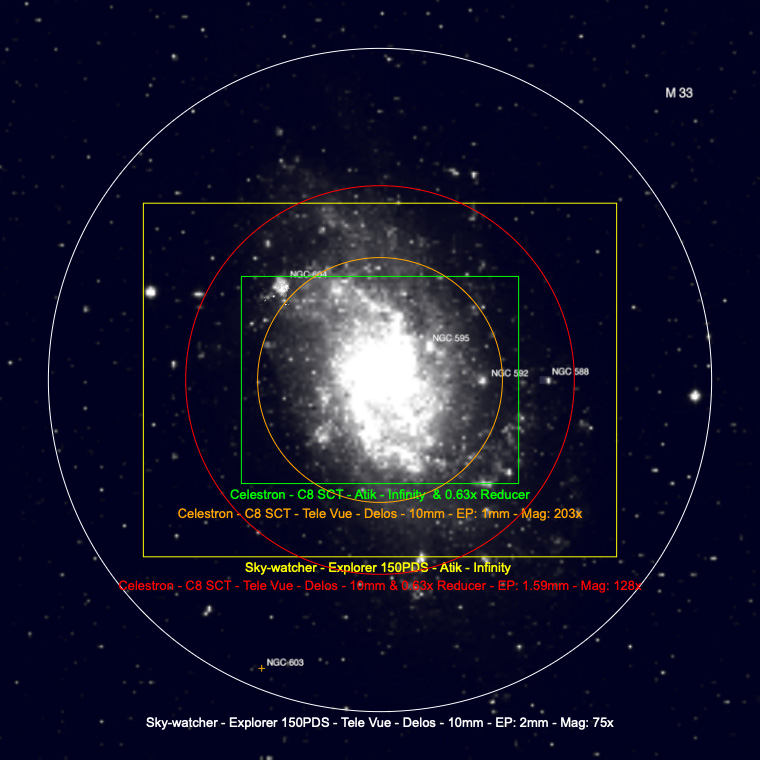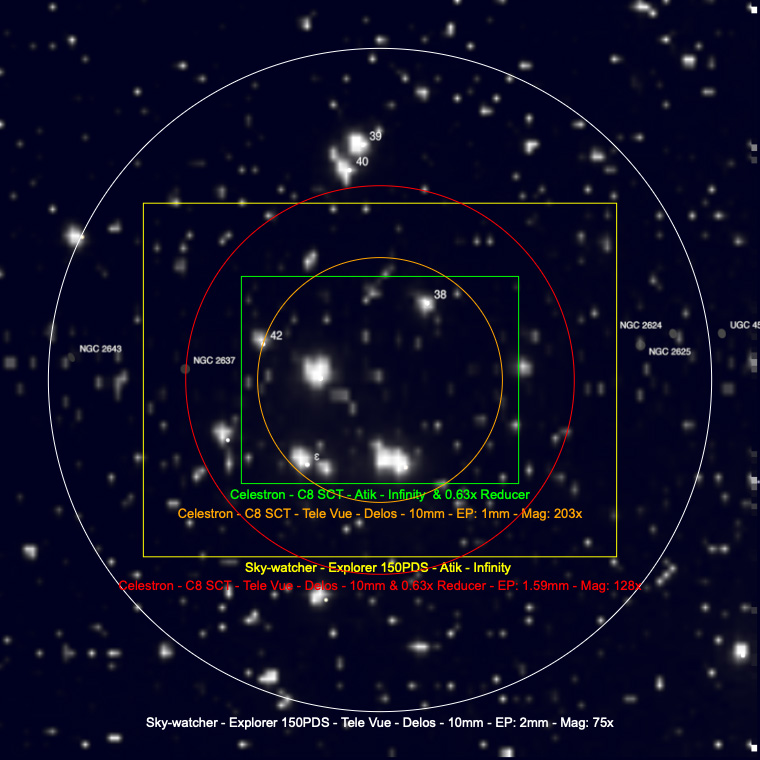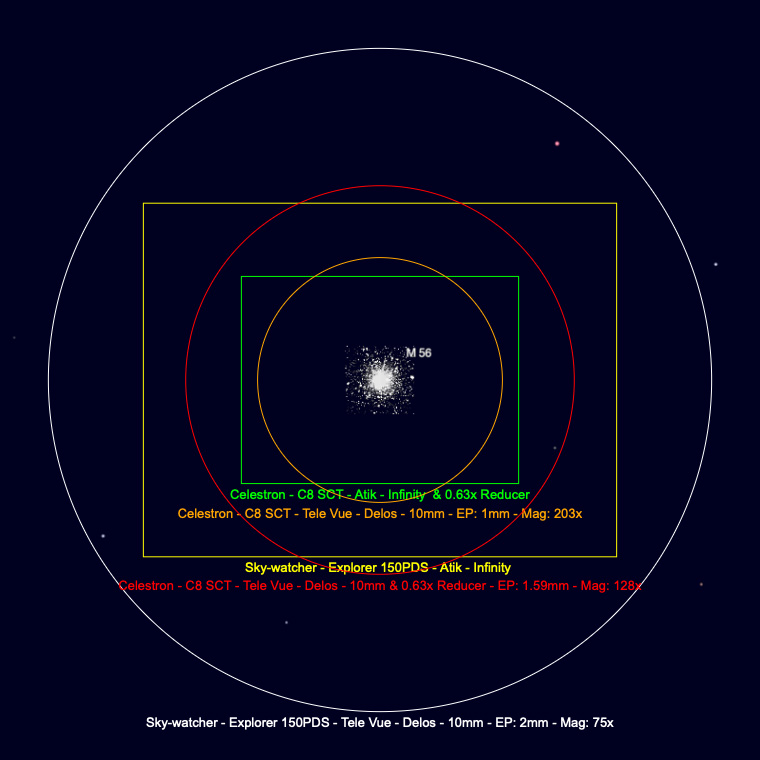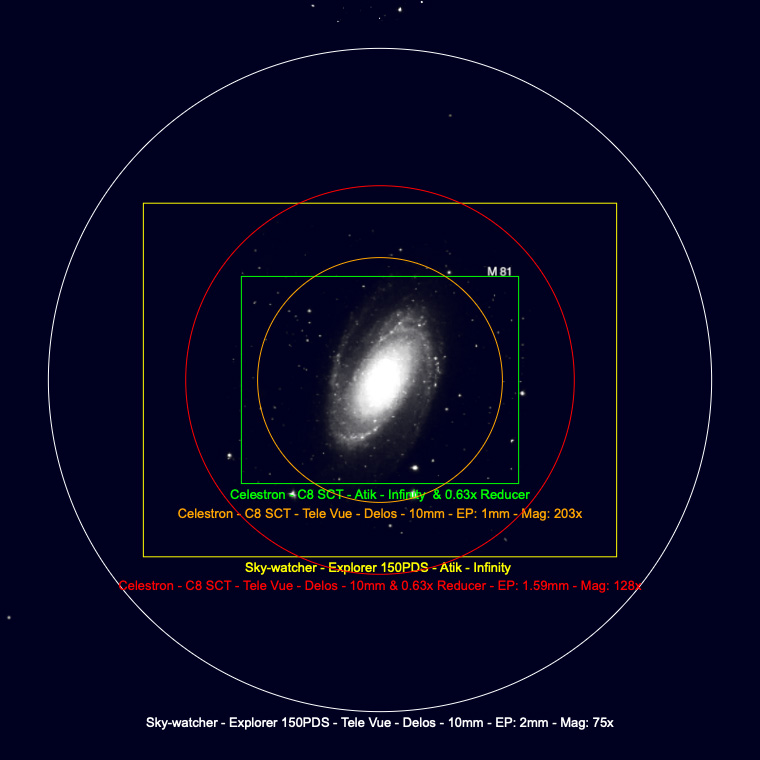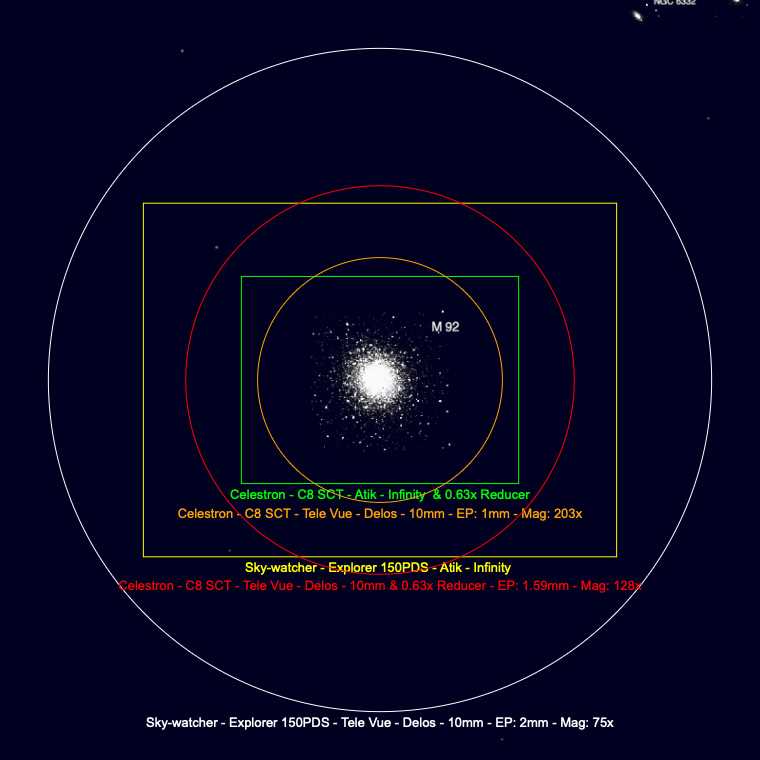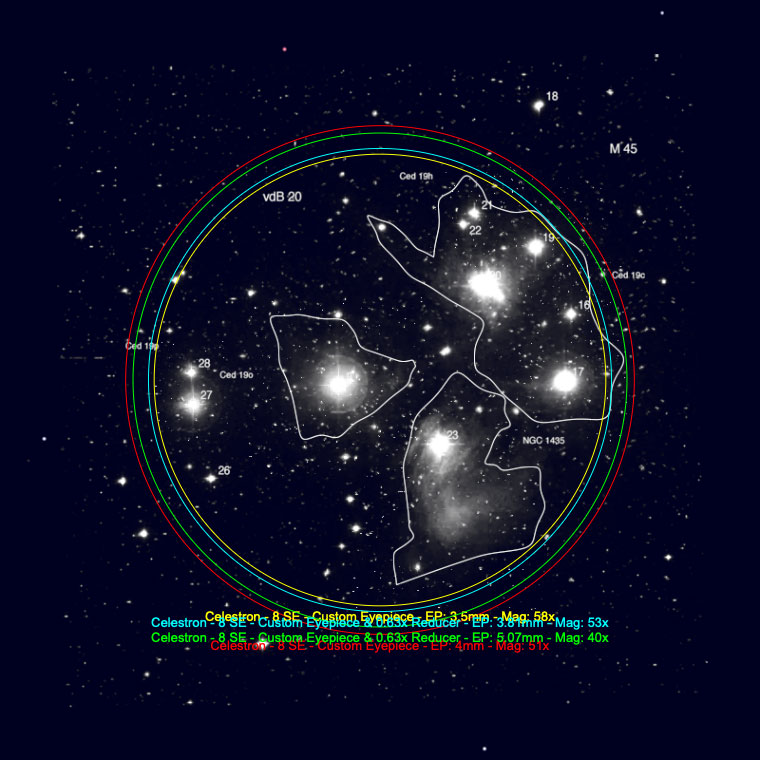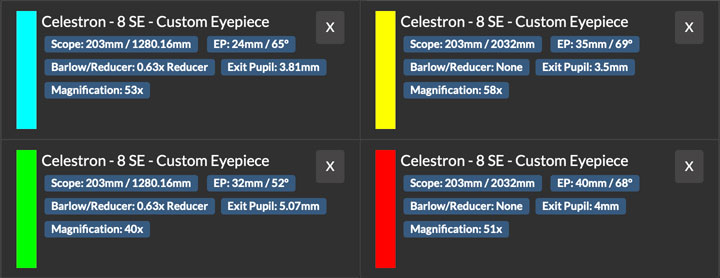C8 - Focal Reducer/Corrector f/6.3
Motivation | Photos | First Experiences... | Preliminary Conclusions | Links | Appendix: FOV Simulations | Appendix 2: Data
Archive
On this page, I present the Celestron SCT reducer/corrector f/6.3 for Celestron and Meade Schmidt-Cassegrain telescopes and my first experiences with it.
| Note: In the beginning of November 2022, I sold my Celestron C8 to a star friend, because I had used it only rarely. I therefore can no longer report any experiences with the C8 here. |
Motivation
The Celestron C8 has a very long focal length and a correspondingly small field of view. So my idea was to buy a focal length reducer, for example the Celestron f/6.3 reducer/corrector, in order to get larger fields of view via a shorter focal length. When I asked my astronomy dealer Mr. Kloß about this, he gave me the short answer: "Visually, this does not help at all!" And if you look at the data in the appendix, you will understand his answer. Since the reducer/corrector is only suited to 1.25" accessories, there are no long eyepiece focal lengths available. Moreover, long focal length 1.25" eyepieces vignet anyway (from a focal length of about 25 mm on, depending on the eyepiece type). So I refrained from buying one initially.
But actually I had bought the C8 to replace two of my existing telescopes, the Skymax-127 and the Explorer 150PDS. My wife vetoed the sale of the Skymax-127, especially since it is suitable for traveling and can be used as a spotting scope. So I wanted to sell at least the Explorer, but then it came to my mind that I need it for the Atik Infinity camera. So what should I do? Determined to sell the Explorer, my only option was to try something with the C8, and the most obvious thing to do was to acquire an f/6.3 reducer/corrector. With 1280 mm, the focal length is still above the maximum recommended 1000 mm for the Atik Infinity, but my hope was that the camera might still come into focus, because the C8 has a lot of reserve. So I ordered a reducer/corrector, the Chinese version, as it turned out afterwards.
Note: In December 2020, I did another "dry run" with the Atik Infinity at the C8 - with and without the f/6.3 reducer/corrector. This time, I managed to get into focus under both conditions. For details see here.
Note: I can also use the f/6.3 reducer/corrector on my Celestron C5 telescope. There, it expands the field of view if you use only 1.25" accessories, that is, it is visually useful as well (I also discuss the usefulness of 2" accessories versus 1.25" accessories plus the reducer/corrector for the C5). And I successfully operated the f/6.3 reducer/corrector at my Sky-Watcher Skymax-127 (by day) - see here!
Photos
Unpacking...
|
Reducer/corrector in the box next to the 1,25" Visual Back |
Box opened, reducer/corrector taken out |
|
Connecting the Reducer/Corrector to the C8
|
Reducer/corrector screwed to the C8 tube |
Ditto, closer view |
|
|
Ditto, closer view |
Photos of the C8 with attached Atik Infinity (Demo Photos)
|
Atik Infinity mounted to the C8 plus reducer/corrector directly (without zenith mirror) |
Ditto from farther away |
Visited Sky Objects
I visited the following sky objects with the Celestron C8:
First Experiences...
Connecting the reducer/corrector to the C8 went without any puzzles or problems on my first attempt. Also the "dry test" with the Atik Infinity camera was hassle-free.
The view through the eyepieces (24 mm and 32 mm) looked good, until I pointed the telescope at a crane. I found the observed pincushion distortions (see the photos above) quite strong! Probably, I will hardly notice them in the sky, both visually and with the Atik Infinity...
Photos: View through two eyepieces with the reducer/corrector
More to come, after I tried the reducer/corrector on the night sky, both visually and with the camera!
Magnification and Exit Pupil
If you look at the table for the exit pupil in the appendix below, it is not recognizable at first sight that, at the same magnification, it is the same for the C8 with and without reducer/corrector. Of course, the formula for the exit pupil clearly show this, whereas the table rather hides this. Of course, the corresponding eyepiece focal lengths are shorter with reducer/corrector, because it creates a shorter focal length.
The First Night: Comparison with and without Reducer/Corrector (January 16, 2020)
On January 16, 2020, I had the first opportunity to compare the C8 with and without reducer/corrector on some DSO. The comparison objects were M 1, M 35, M 36, M 37, M 38, M 42/43 and M 45. With the reducer/corrector I used my 24 mm Televue eyepiece (1.25", 65° apparent angle of view => 1.22° angle of view, EP = 3.81) without reducer/corrector my 40 mm Lacerta eyepiece (2", 68° apparent angle of view => 1.34° angle of view, EP = 4.0). Overall, the field of view was very similar in both conditions.
To reduce the effort, I first observed all objects with the reducer/corrector and then without. Thus I cannot really speak of a "comparison". I did not notice any significant differences between the two configurations, except that without reducer/corrector the image seemed a little larger due to the larger apparent field of view, which I found pleasant. The Crab Nebula M 1 was very faint in both configurations, but maybe a little brighter with reducer/corrector - maybe a consequence of the aperture ratio of f/6.3 (on the other hand, the EP was slightly larger without reducer/corrector).
Overall, I was very satisfied with the results of the reducer/corrector in this comparison. I also did not notice the strong pincushion distortions that I had found during daylight. But without straight lines in the field of view finding distortions is difficult...
This practical test, of course, confirmed what I had already heard and what the technical data state: Visually, the Reducer/Corrector does not offer any advantages, at least not with respect to a larger field of view (the 1.25" 32 mm eyepiece comes close to the 2" 40 mm eyepiece, but still has a smaller field of view).
If, on a certain occasion, you want to observe only with 1.25" eyepiece and can do without the highest magnifications, then the reducer/corrector is definitely a simple and efficient solution because you need not handle heavy and large 2 accessories and can use the 1.25" zenith mirror..
A First Nightly Test with the Reducer/Corrector at the Atik Infinity (March 15, 2020)
On 15.3.2020, I made a first "night test" with the Atik Infinity camera at the Celestron C8. I tested the following two configurations: (1) f/6.3 reducer/corrector and 1.25" zenith prism, (2) f/6.3 reducer/corrector, 0.5x TS focal reducer (screwed into the camera) and 1.25" zenith prism. The telescope was mounted on the Star Discovery mount, which I operated with the SynScan WLAN module via the SynScan app on the iPhone. Here are some of the "best" photos I took during this test session:
All in all I found the results, apart from those for M 42/43, fairly disappointing, but I was not that much in practice with the camera anymore... Faint objects like the Flame Nebula NGC 2024 were very pale, which did not get much better in post-processing (even though they were saved as 16 bit TIFF files). I got vignetting with the additional 0.5x TS focal reducer, which is more or less annoying depending on the object. On the other hand, you get a much larger field of view (about 0.8° against 0.4°, thus about 48' against 24'; the latter FOV does not even capture the moon as a whole).
Dry Runs with Atik Infinity
In a number of "dry runs " (December 2020) I checked again and several times, whether the Atik Infinity camera can be operated at the C8 with and without reducer/corrector and without further equipment, that is, only with the 1.25" visual back. This was indeed the case (even if this somewhat contradicts older tests...). Below are some example photos:
|
C8 with 1.25" Visual Back and f/6.3 Reducer/Corrector |
C8 with 1.25" Visual Back |
C8 with 1.25" Visual Back |
|
Result for photo above |
Result for photo above |
Visual Use of the Reducer/Corrector
After I had heard from all sides that the visual use of the reducer/corrector does not make any sense, and since this is also confirmed by my eyepiece data tables, I initially did nothing in this direction. Instead, I tried the reducer/corrector at the C5, where it extended the field of view to larger fields of view. Until I learned, that you can also run 2" accessories on the C5... I tried this, it seemed to work, and so I also came to the conclusion that the solutions 2" accessories versus 1.25" accessories and reducer/corrector lead to equivalent fields of view. Which solution is to be preferred, I was not able to find out so far...
Then I had the idea to try the reducer/corrector at the C5 together with 2" accessories. Actually, I had assumed that this is not intended for this. On the other hand, 2" accessories can be mounted to it without any problems. As a result, I found that my 26 mm eyepiece did not vignette, but both the 35 and the 40 mm eyepiece did - and both provided about the same field of view. This inspired me to try out the same thing at the C8. Since its rear baffle has a diameter of 38 mm (that of the C5 has one of 25 mm), I did not expect any vignetting. But in fact, I got a similar result as with the C5 with respect to the vignetting! This means that in the case of vignetting not the rear baffle but the reducer/corrector together with the 2" zenith mirror form the bottleneck (two different 2" zenith mirrors gave comparable results). All in all, one obtains larger fields of view in this way than with all other solutions, but not as large as calculated (the photos show that the field of view is smaller with the C8 than with the C5...). In any case, it is then sufficient to use the 35 mm eyepiece.
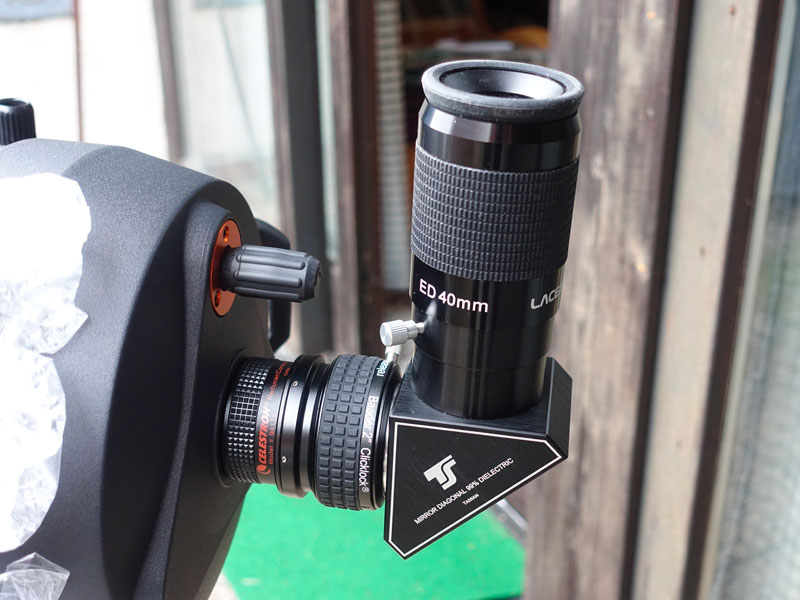 |
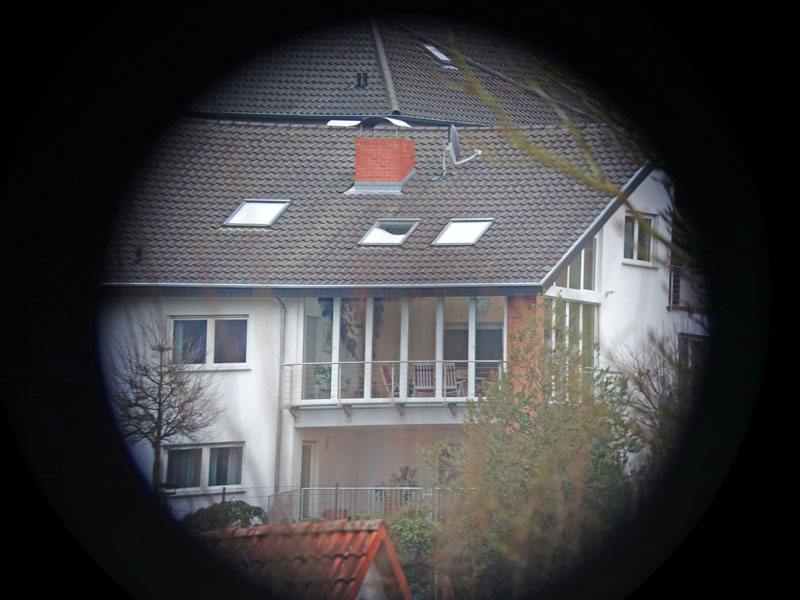 |
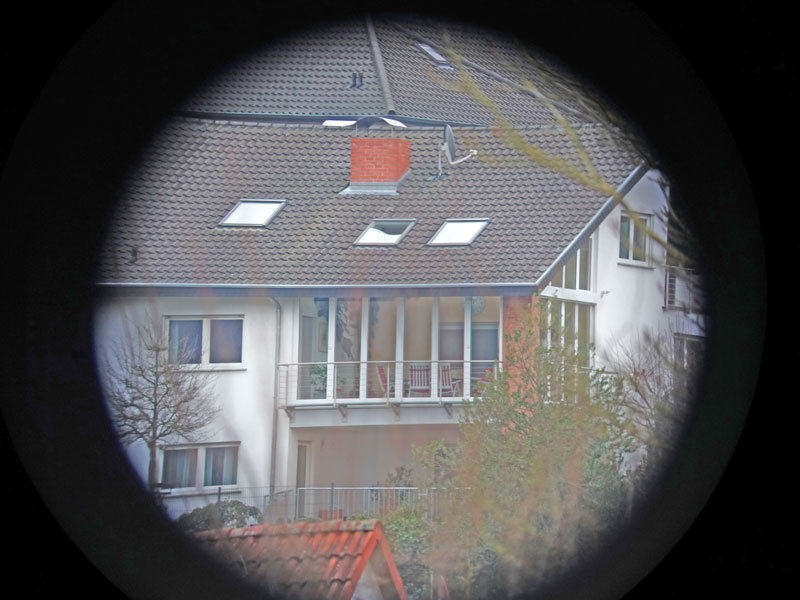 |
||
40 mm eyepiece (2", 68°) with reducer/corrector |
Image somewhat made brighter |
Image made very bright to show the field of view |
Preliminary Conclusions
For first conclusions my trials do not suffice...
Note: In the beginning of November 2022, I sold my Celestron C8 to a star friend, because I had used it only rarely. I therefore can no longer report any experiences with the C8 here.
Links
- See also my page offering Astronomy Links.
Appendix: FOV Simulations
Field of View Simulations for Various DSO
For the C8 with a f/6.3 reducer, I used the astronomy.tools Field of View tool to demonstrate how certain Messier objects fit the field of view of the Atik Infinity camera. In addition, I calculated this for the Explorer 150PDS which I had used with the camera in the past. Finally, I also calculated the field of view in my 10 mm TeleVue Delos eyepiece (72° apparent field of view), which has a comparable field of view to the Atik Infinity camera.
Here are the color codings for the different configurations of my equipment:
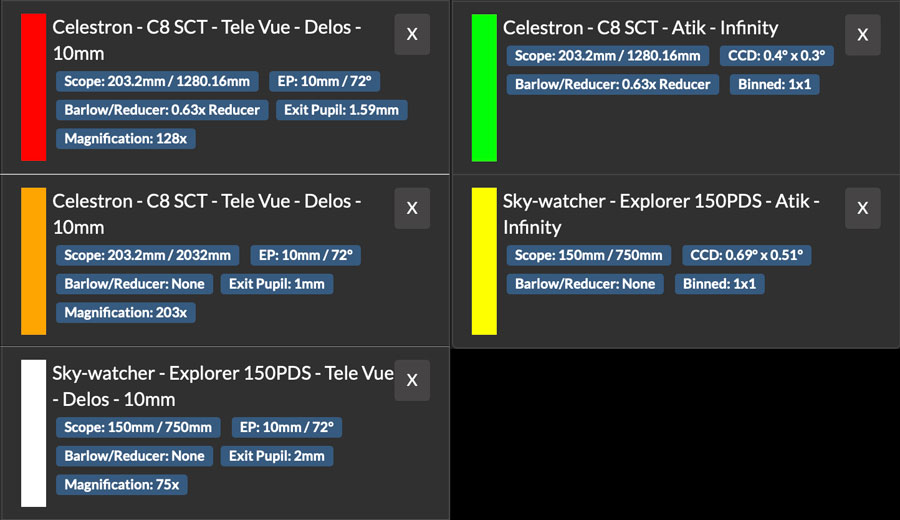
Note that the field of view is considerably smaller for the C8 even when used with a f/6.3 reducer/corrector than that of the Explorer 150PDS.
|
M 8 |
M 11 |
|
M 13 |
M 16 |
|
M 17 |
M 27 |
|
M 31 |
M 33 |
|
M 44 |
M 56 |
|
M 81 |
M 92 |
FOV Comparison with and without Reducer/Corrector
Moreover, I simulated, which FOV can be achieved using my 1.25" and 2" eyepieces, the first ones for use with the reducer/corrector, the second ones for use without it. In the end, there is little difference between the two configurations, and this is another proof that the reducer/corrector does not allow for a wider FOV- as I had hoped for...
|
Left: 1.25" eyepieces (with reducer/corrector) Right: 2" eyepieces (no reducer/corrector) |
Appendix 2: Data for Celestron C8 with f/6.3 Reducer/Corrector
Observation-Relevant Data (in Comparison with my 6" Newton Tube)
| Telescope | Focal Length (mm) |
Aperture (mm) |
Focal Ratio |
Light Gathering Power |
Maximum+ |
Minimum* |
Maximum* |
Minimum+ |
|||||
Usable Magnification |
Usable Focal
Length of Eyepiece (mm) |
||||||||||||
Factor/Exit Pupil (mm) > |
Manuf. |
1.5 |
2 |
6.5 |
7 |
6.5 |
7 |
1.5 |
2 |
||||
| Celestron C8 (Schmidt-Cassegrain) | 2032 |
203 |
10 |
841 |
305 |
406 |
31.26 |
29.03 |
65.0 |
70.0 |
6.7 |
5.0 |
|
| Cel. C8 (Schmidt-Cassegrain) (Red.) | 1280 |
203 |
6.3 |
841 |
305 |
406 |
31.26 |
29.03 |
41.0 |
44.1 |
4.2 |
3.2 |
|
| Skymax-102 (Maksutov-Cassegrain) | 1300 |
102 |
12.75 |
212 |
153 |
204 |
15.69 |
14.57 |
82.9 |
89.3 |
8.5 |
6.4 |
|
| Skymax-127 (Maksutov-Cassegrain) | 1500 |
127 |
11.81 |
329 |
191 |
254 |
19.54 |
18.14 |
76.8 |
82.7 |
7.9 |
5.9 |
|
| Explorer PDS150/Dobson 6" | 750 |
150
|
5 |
459 |
225 |
300 |
23.08 |
21.43 |
32.5 |
35.0 |
3.3 |
2.5 |
|
*) Calculated for an exit pupil of 6.5 mm and 7 mm
+) Factor 1.5 or 2 for Dobsonian/Newtonian telescopes; in general, the lower
value of 1.5 is used for Newtonian telescopes; if the manufacturer specified
a different magnification, it is also listed (some manufacturer provide considerably
higher numbers...).
Visual Power (Magnification) and Other Data for Different Focal Lengths of Eyepieces (Mostly My Current Eyepieces)
Note: These tables include the StarTravel 120 refractor, a TSWA32 eyepiece (2", 32 mm focal length, 70° viewing angle) that I borrowed together with the StarTravel 120, a 18 mm eyepiece (2", 82° viewing angle), a 38 mm eyepiece (2", 70° viewing angle), and a 56 mm eyepiece (2", 52° viewing angle).
I did not include the Celestron 25 mm Plössl eyepiece, which is delivered with the C8 (given away) and the C5 (still have it)...
| Telescope | Further Data |
Focal Length of Eyepiece (mm) |
|||||||||||||
| Magnification | |||||||||||||||
Focal Length of Telescope (mm) |
4 |
7 |
10 |
16 |
18 |
24 |
26 |
28 |
32 |
32 |
35 |
38 |
40 |
56 |
|
| PS 72/432 | 432 |
108.00 |
61.71 |
43.20 |
27.00 |
24.00 |
18.00 |
16.62 |
15.43 |
13.50 |
13.50 |
12.34 |
11.37 |
10.80 |
7.71 |
| ST120 | 600 |
150.00 |
85.71 |
60.00 |
37.50 |
33.33 |
25.00 |
23.08 |
21.43 |
18.75 |
18.75 |
17.14 |
15.79 |
15.00 |
10.71 |
| TLAPO1027 | 714 |
178.50 |
102.00 |
71.40 |
44.63 |
39.67 |
29.75 |
27.46 |
25.50 |
22.31 |
22.31 |
20.40 |
18.79 |
17.85 |
12.75 |
| 150PDS | 750 |
187.50 |
107.14 |
75.00 |
46.88 |
41.67 |
31.25 |
28.85 |
26.79 |
23.44 |
23.44 |
21.43 |
19.74 |
18.75 |
13.39 |
| Skymax-127 | 1500 |
375.00 |
214.29 |
150.00 |
93.75 |
--- |
62.50 |
--- |
--- |
46.88 |
--- |
--- |
--- |
--- |
--- |
| Skymax-102 | 1300 |
325.00 |
185.71 |
130.00 |
81.25 |
--- |
54.17 |
--- |
--- |
40.63 |
--- |
--- |
--- |
--- |
--- |
| C5 | 1250 |
312.50 |
178.57 |
125.00 |
78.13 |
69.44 |
52.08 |
48.08 |
44.64 |
39.06 |
39.06 |
35.71 |
32.89 |
31.25 |
22.32 |
| C5 (Red.) | 787.5 |
196.88 |
112.50 |
78.75 |
49.22 |
--- |
32.81 |
30.29 |
--- |
24.61 |
--- |
22.50 |
--- |
19.69 |
--- |
| C8 | 2032 |
508.00 |
290.29 |
203.20 |
127.00 |
112.89 |
84.67 |
78.15 |
72.57 |
63.50 |
63.50 |
58.06 |
53.47 |
50.80 |
36.29 |
| C8 (Red.) | 1280 |
320.00 |
182.86 |
128.00 |
80.00 |
--- |
53.33 |
49.23 |
--- |
40.00 |
--- |
36.57 |
--- |
32.00 |
--- |
| True Field of View (°) | |||||||||||||||
Apparent Field
of View (°) > |
82 |
82 |
72 |
82 |
82 |
65 |
70 |
56 |
52 |
70 |
69 |
70 |
68 |
52 |
|
Focal Length of Telescope (mm) |
4 |
7 |
10 |
16 |
18 |
24 |
26 |
28 |
32 |
32 |
35 |
38 |
40 |
56 |
|
| PS 72/432 | 432 |
0.76 |
1.33 |
1.67 |
3.04 |
3.42 |
3.61 |
4.21 |
3.63 |
3.85 |
5.19 |
5.59 |
6.16 |
6.30 |
6.74 |
| ST120 | 600 |
0.55 |
0.96 |
1.20 |
2.19 |
2.46 |
2.60 |
3.03 |
2.61 |
2.77 |
3.73 |
4.03 |
4.43 |
4.53 |
4.85 |
| TLAPO1027 | 714 |
0.46 |
0.80 |
0.91 |
1.84 |
2.07 |
2.18 |
2.55 |
2.20 |
2.33 |
3.14 |
3.38 |
3.73 |
3.92 |
4.08 |
| 150PDS | 750 |
0.44 |
0.77 |
0.96 |
1.75 |
1.97 |
2.08 |
2.43 |
2.09 |
2.22 |
2.99 |
3.22 |
3.55 |
3.63 |
3.88 |
| Skymax-127 | 1500 |
0.22 |
0.38 |
0.48 |
0.87 |
--- |
1.04 |
--- |
--- |
1.11 |
--- |
--- |
--- |
--- |
--- |
| Skymax-102 | 1300 |
0.25 |
0.44 |
0.55 |
1.01 |
--- |
1.20 |
--- |
--- |
1.28 |
--- |
--- |
--- |
--- |
--- |
| C5 | 1250 |
0.26 |
0.46 |
0.58 |
1.05 |
1.18 |
1.25 |
1.46 |
1.25 |
1.33 |
1.79 |
1.93 |
2.13 |
2.18 |
2.33 |
| C5 (Red.) | 787.5 |
0.42 |
0.73 |
0.91 |
1.67 |
--- |
1.98 |
2.31 |
--- |
2.11 |
--- |
3.07 |
--- |
3.45 |
--- |
| C8 | 2032 |
0.16 |
0.28 |
0.35 |
0.65 |
0.73 |
0.77 |
0.90 |
0.77 |
0.82 |
1.10 |
1.19 |
1.31 |
1.34 |
1.43 |
| C8 (Red.) | 1280 |
0.26 |
0.45 |
0.63 |
1.03 |
--- |
1.22 |
1.42 |
--- |
1.30 |
--- |
1.89 |
--- |
2.13 |
--- |
| Exit Pupil (mm) | |||||||||||||||
Focal Ratio |
4 |
7 |
10 |
16 |
18 |
24 |
26 |
28 |
32 |
32 |
35 |
38 |
40 |
56 |
|
| PS 72/432 | 6 |
0.67 |
1.17 |
1.67 |
2.67 |
3.00 |
4.00 |
4.33 |
4.67 |
5.33 |
5.33 |
5.83 |
6.33 |
6.67 |
9.33 |
| ST120 | 5 |
0.80 |
1.40 |
2.00 |
3.20 |
3.60 |
4.80 |
5.20 |
5.60 |
6.40 |
6.40 |
7.00 |
7.60 |
8.00 |
11.20 |
| TLAPO1027 | 7 |
0.57 |
1.00 |
1.43 |
2.29 |
2.57 |
3.43 |
3.71 |
4.00 |
4.57 |
4.57 |
5.00 |
5.43 |
5.71 |
8.00 |
| 150PDS | 5 |
0.80 |
1.40 |
2.00 |
3.20 |
3.60 |
4.80 |
5.20 |
5.60 |
6.40 |
6.40 |
7.00 |
7.60 |
8.00 |
11.20 |
| Skymax-127 | 11.81 |
0.34 |
0.59 |
0.85 |
1.35 |
--- |
2.03 |
--- |
--- |
2.71 |
--- |
--- |
--- |
--- |
--- |
| Skymax-102 | 12.75 |
0.31 |
0.55 |
0.78 |
1.26 |
--- |
1.88 |
--- |
--- |
2.51 |
--- |
--- |
--- |
--- |
--- |
| C5 | 10 |
0.40 |
0.70 |
1.00 |
1.60 |
1.80 |
2.40 |
2.60 |
2.80 |
3.20 |
3.20 |
3.50 |
3.80 |
4.00 |
5.60 |
| C5 (Red.) | 6.3 |
0.63 |
1.11 |
1.59 |
2.54 |
--- |
3.81 |
4.13 |
--- |
5.08 |
--- |
5.56 |
--- |
6.35 |
--- |
| C8 | 10 |
0.40 |
0.70 |
1.00 |
1.60 |
1.80 |
2.40 |
2.60 |
2.80 |
3.20 |
3.20 |
3.50 |
3.80 |
4.00 |
5.60 |
| C8 (Red.) | 6.3 |
0.63 |
1.11 |
1.59 |
2.54 |
--- |
3.81 |
4.13 |
--- |
5.08 |
--- |
5.56 |
--- |
6.35 |
--- |
Blue: Equipment borrowed for comparison purposes; gray: sold equipment; italic: 2" eyepieces
Magnification: Yellow: low (30-50 x); magenta: medium
(80-100 x); violet: high (150-200 x - and more); red: beyond
maximum usable magnification.
Exit pupil: Values in magenta cells are
either too small (< 1 mm) or too large (> 6.4/7 mm); yellow background:
best for galaxies (about 2-3 mm).
Recommendations for the Focal Lengths of Eyepieces for Celestron C8 with f/6.3 Reducer/Corrector (Following My Recommendations and Those of Others)
| Criteria | Exit Pupil | Focal
Length of Eyepiece |
|||||
| Category | Application Area | from...to |
Calculated |
On the Market |
Examples |
Existing |
|
| Maximum FOV | Search | 7 |
10 |
44-63** |
40 |
56* |
--- |
| Minimum Magnification / Large FOV | Overview, large-area nebulae | 4.5 |
6.5 |
28-41 |
25-40 |
28, 32, 40 |
32 |
| Normal Magnification | Large-area, faint nebulae; nebulae, open star clusters | 3.5 |
4 |
22-25 |
20-25 |
20, 24, 25 |
24 |
| Best for many objects, e.g. for most galaxies, and mid-size DSO | 2 |
3 |
12.5-19 |
12.5-18 |
12.5, 15, 16, 18 |
16 |
|
| Maximum Magnification / Maximum Resolution | "Normal" upper magnification limit; globular star clusters | 1 |
1.5 |
6.3-9.5 |
6.5-9.5 |
6.5, 7, 9 |
7, 10 |
| Maximum perceptibility of small, low-contrast
details; planetary nebulae, small galaxies; maximum magnification for moon and planets |
0.6 |
0.8 |
3.5-5 |
3.5-5 |
3.5, 4, 6 |
4 |
|
| Separation of narrow double stars, small planetary
nebulae; perception of faintest details |
0.4 |
0.5 |
2.5-3.2 |
2.5-3.5 |
2.5, 3, 3.5 |
--- |
|
*) Partly available as 2" eyepiece; **) typically no suitable 1.25" eyepieces available; problems with viewing at 40 mm; italic: not possible; red: magnification too high; blue: commercial focal lengths
| 07.10.2024 |

